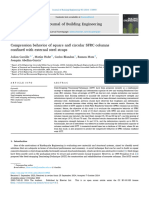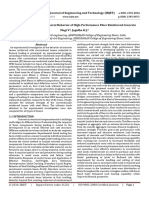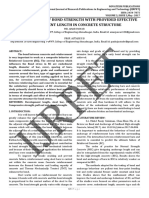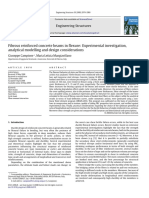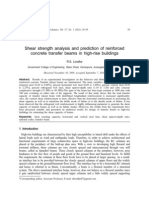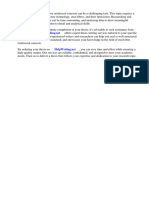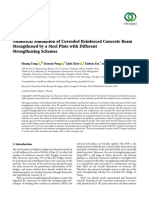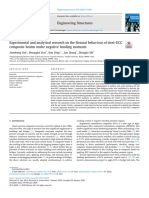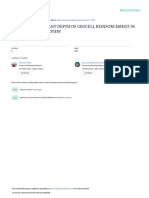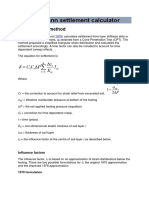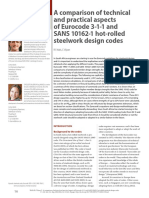Experimental Study of Steel Fiber Prestressed Concrete Beam For Shear, Bending and Torsion
Experimental Study of Steel Fiber Prestressed Concrete Beam For Shear, Bending and Torsion
Uploaded by
Chaitali patilCopyright:
Available Formats
Experimental Study of Steel Fiber Prestressed Concrete Beam For Shear, Bending and Torsion
Experimental Study of Steel Fiber Prestressed Concrete Beam For Shear, Bending and Torsion
Uploaded by
Chaitali patilOriginal Title
Copyright
Available Formats
Share this document
Did you find this document useful?
Is this content inappropriate?
Copyright:
Available Formats
Experimental Study of Steel Fiber Prestressed Concrete Beam For Shear, Bending and Torsion
Experimental Study of Steel Fiber Prestressed Concrete Beam For Shear, Bending and Torsion
Uploaded by
Chaitali patilCopyright:
Available Formats
IOSR Journal of Mechanical and Civil Engineering (IOSR-JMCE)
e-ISSN : 2278-1684, p-ISSN : 2320–334X
PP 68-83
www.iosrjournals.org
Experimental Study of Steel Fiber Prestressed Concrete Beam for
Shear, Bending and Torsion
Satyajeet B. Mopari1, Ajinkya D. Raut2
1
(Civil Dept, R.S.C.O.E. / Pune University, India)
2
(Civil Dept, R.S.C.O.E. / Pune University, India)
Abstract : In this modern age, civil engineering constructions have their own structural and durability
requirements. Fiber Reinforced Concrete (FRC) is a composite material made primarily from hydraulic
cements, aggregates and discrete reinforcing fibers. Fiber incorporation in concrete, mortar and cement paste
enhances many of the engineering properties of these materials such as fracture toughness, flexural strength,
resistance to fatigue, impact, thermal shock and spalling.The FRC is a composite material made of cement, fine
and coarse aggregates and discontinuous discrete steel fibers. Recently developed an analytical model to
predict the shear, tensional strength and bending torsion behavior of fiber reinforced concrete beam with
experimental substantiation. However, very little work has been reported in combined torsion and shear.
Similarly to beam with conversional reinforcement, the presence of shear may significance influence on
tensional strength of fiber concrete beams. Present paper investigates the mechanical properties like as shear
strength, and torsion strength of concrete with different types of steel fiber with constant volume fractions and
different aspect ratio.A primary finding emerging from the experimental program was that the placement of
fibers, increased load carrying capacity of high strength fiber reinforced concrete [HSFRC] beam. Ductility,
toughness significantly improved.
Keywords: Aspect ratio, Fatigue, Flexural strength, Fracture toughness, Mechanical properties, Volume
fraction, HSFRC, steel fiber, Flexural strength; Load–deflection response; High-strength fiber concrete.
I. INTRODUCTION
The well-known inherent deficiencies of concrete are its tensile strength and its brittleness. These
weaknesses of concrete lead to immediate collapse of plain concrete beams after formation of the first crack and
its propagation, at very low values of tensile stress developed in the cross section due to direct (axial) and / or
indirect (flexural, shear or torsional) nature of loading. These deficiencies are overcome by fiber reinforced
concrete and pre-stressed concrete systems. These systems are not improving the weaknesses of the concrete
matrix but are aiding the concrete with tensile reinforcement for sharing almost totally the tensile load on the
elements. They and many other investigators have well established that the inclusion of high strength, high
elasticity modulus steel fibers of short length and small diameter enhances the tensile strength, ductility and
other properties of concrete significantly and also acts as crack arrestors. Concrete with steel fibers is known as
steel fiber reinforced concrete (SFRC).
The members of a fiber reinforced concrete structures are subjected to shear forces, axial forces,
bending moments and torsional moments. Many researchers carried out tests on reinforced concrete beams
under bending-shear-torsion, bending-torsion and shear torsion and proposed modes of failure, empirical
formulae and interaction curves. The investigations made in the field of the analysis of behavior of SFRC
rectangular beams in combined loading, available in the literature, are fewer as compared with that in the field
of pure torsion. In the present investigation 24 fiber reinforced concrete beams with steel fibers were tested
under combined torsion-bending-shear.
The objective of this paper is to investigate the mechanical properties like as shear strength, and
torsion strength of concrete with different types of steel fiber with constant volume fractions and different aspect
ratio.
II. LITERATURE REVIEW
Concrete is a complex material. Innovative structural application is improving performance of
concrete. Prestress concrete is also playing major role throughout the world. High performance fiber reinforced
prestress concrete beam can prove better on all fronts. The addition of fibers considerably improves the static,
flexural strength, impact strength, tensile strength, fatigue strength, ductility, and flexural toughness shear
capacity of concrete. The degree of improvement in the above cited parameters depends on many factors
including size, type aspect ratio, and volume fraction of fibers.
Innovation in engineering science and technology (NCIEST-2015) 68 | Page
JSPM’S Rajarshi Shahu College Of Engineering,Pune-33,Maharashtra ,India
IOSR Journal of Mechanical and Civil Engineering (IOSR-JMCE)
e-ISSN : 2278-1684, p-ISSN : 2320–334X
PP 68-83
www.iosrjournals.org
There is few work done on the torsion to the beam, we at engineeringcivil.com are thankful to Er.
Yogesh Ravindra Suryawanshi for submitting this research paper to us. In the beginning all basic tests are
conducted on all ingredient material of concrete, viz. cement, fine aggregate, coarse aggregate, water and steel
fibers. ACC 43 grade cement conforming to IS 12269 – 1987 is used. River sand is used as fine aggregates,
obtained from local river bed. Crushed black trap basalt is used conforming to IS 383 – 1970 of size 10 to 20
mm is used. Sulphonated Naphthalene formaldehyde polymer is used as superplasticizer having brand name as
MasterPlast SPL – 9. The dose of superplasticizer is 4% of weight of cement. Three type of steel fibers, hook
ended (HK – 80/60) aspect ratio 80, hook ended (HK – 50/30) aspect ratio 50, crimped (CR – 50/30) aspect ratio
50, Round fibers (RD – 50/80) aspect ratio 50 and Round fibers (RD 80/130) aspect ratio 80, all conforming to
ASTM A type I are used for the experimental work. The experimental investigation consists of total 36 beam
specimens casted and tested for combined shear and torsion. All beams are tested after 28 days of curing. For
each type of fiber, the percentage of fiber is kept constant as 2.5%. Out of 36 beams, 6 beams are with 0% fiber
content. Total 18 beams are casted with longitudinal reinforcement of 4 numbers of bars, 8 mm diameter, 2 at
top and 2 at bottom. The proportioning of concrete is maintained constant throughout the investigation. A
concrete mix targeting a compressive strength of 25 MPa is used. Figure 2.1 shows the cross sectional details of
the beam loading arrangement. An effective cover of 15 mm is provided for the transverse reinforcement. The
cured beams are white washed a day before testing to facilitate the crack identification. One end of the beam is
supported on rollers, while the other end is supported on rigid support. This type of test setup facilitates free
rotation of roller end and provides stability to the test specimen during testing. Specially made twist arms or
twist angles are placed at both supports of the beam having an arm length of 0.60 m. Load on the twist arm is
applied through a hydraulic jack and the loading is monitored through a proving ring attached to the jack.
Absolute care has taken, such that, the plane of loading and twisting arm are perpendicular to the longitudinal
axis of the beam. This avoids any possibility of bending of the beam instead of twisting and as a result the beam
between the two supports is subjected to pure torsion. The complete test setup is schematically presented in
figure 2.2. Load is applied at an eccentricity of 0.66 m from the center of the beam. For every applied load, the
corresponding dial gauge readings are noted which were placed at L/3 distance from ends and considering
average value of the two reading.
An experimental work on the steel fiber reinforced concrete to analyze effective moment of Inertia and
flexural rigidity was reported by J Premalatha and R Sundara rajan. In this experimental work eighteen beams
with 8mpa compressive strength and having tension and compression reinforcement and deformed steel fibers
were tested under two point loading. The flexural rigidity (EI) of cracked rectangular reinforced concrete beams
with steel fibers was evaluated experimentally. Considering the steel fibers influence compression and tension
reinforcement a change ACI building code method for estimating the effective moment of inertia of the section
for the reinforced high strength fibrous concrete beams is proposed. The effective moment of inertia estimated
using the changed methods compared with the experimental results. The results of the investigation can be
summarized as follows. Addition of steel fibers increases the beam stiffness thus reduces the deflection for a
given load. The value of m used in the effective moment of inertia formula equation decreases with increase in
fiber volume fraction. Increase in longitudinal reinforcement ratio from 0.01 to 0.03 in tested beams resulted in
17% increase in flexural rigidity. Increase in volume fraction of steel fibers from 0 to 1.5% in tested beams
resulted in 21% increase in flexural rigidity.
III. Prestress Concrete
Concrete is presently the most widely used construction material. Because of its specialty of being cast
in any desirable shape, it has replaced stone and brick masonry. In spite of all this, it has some serious
deficiencies which for its remarkable qualities of flexibility, resilience and ability to redistribute stress, would
have prevented its use as a building material. Plain, unreinforced concrete is a brittle material, with a low tensile
strength and a low strain capacity. Plain concrete is inherently weak in tension and has limited ductility and little
resistance to cracking. Micro cracks are inherently present in concrete and because of this low tensile strength;
cracks propagate with application of the load, leading to brittle fracture in concrete. The low tensile strength of
concrete is being compensated for in several ways and this has been achieved by use of Reinforcing Bars and
also by applying Prestressing Techniques.
The prestressing and pre-casting of concrete are inter-related features of the modern building industry.
Through the application of imaginative design and quality control, they have, since the 1930’s, had an
increasing impact on architectural and construction procedures. Prestressing of concrete is the application of a
compressive force to concrete members and may be achieved by either pre-tensioning high tensile steel strands
Innovation in engineering science and technology (NCIEST-2015) 69 | Page
JSPM’S Rajarshi Shahu College Of Engineering,Pune-33,Maharashtra ,India
IOSR Journal of Mechanical and Civil Engineering (IOSR-JMCE)
e-ISSN : 2278-1684, p-ISSN : 2320–334X
PP 68-83
www.iosrjournals.org
before the concrete has set, or by post-tensioning the strands after the concrete has set. Although these
techniques are commonplace, misunderstanding of the principles, and the way they are applied, still exists. To
avoid this one should have proper knowledge of Prestressing techniques.
IV. TORSION TO THE BEAM
Torsion occurs more frequently in most structure but rarely occurs alone. However, torsion forms one
of the basic structural actions besides flexure, shear and axial compression/tension. Torsional failure of concrete
member is initiated by the tensile stress developed due to a state of pure shear, which arises due to torsion.
Inclusion of steel fibers principally may increase the tensile strength of the matrix to a moderate level but the
toughness will be enhanced to a greater extent. This particular advantage of fiber reinforced concrete inspired
the different conditions of study its mechanical properties under different conditions of loading. But little
information is available on the to behavior of fiber reinforced concrete members under pure torsion. Earlier
investigation indicated that the addition of fibers improves the torsional strength and ductility of member. In this
investigation an attempt has been made to quantify the effect of fibers in resisting torsional loads. Also a semi
empirical formula for predicting the ultimate torsional strength of the SFRC member has been presented.
V. FLEXURAL STRESSES IN BEAMS
A beam is a structural member whose length is large compared to its cross sectional area which is
loaded and supported in the direction transverse to its axis. Lateral loads acting on the beam cause the beam to
bend or flex, thereby deforming the axis of the beam into a curved line. In previous chapter prestressing method
was discussed. In this chapter flexural behaviour of prestressed beam is discussed.
When prestressed concrete members are subjected to bending loads, different types of flexural failures
are possible at critical sections, depending upon the principal controlling parameters, such as the percentage of
reinforcement in the section, degree of bond between tendons and concrete, compressive strength of concrete
and the ultimate tensile strength of the tendons. In the post-cracking stage, the behavior of a prestressed concrete
member is more similar to that of a reinforced concrete member and the theories used for estimating the flexural
strength of reinforced concrete section may as well be used for prestressed concrete sections.
Flexural testing on beam with single point loading –
Innovation in engineering science and technology (NCIEST-2015) 70 | Page
JSPM’S Rajarshi Shahu College Of Engineering,Pune-33,Maharashtra ,India
IOSR Journal of Mechanical and Civil Engineering (IOSR-JMCE)
e-ISSN : 2278-1684, p-ISSN : 2320–334X
PP 68-83
www.iosrjournals.org
Flexural testing on beam with double point loading –
VI. PROJECT EXECUTION WORK
In this project, an attempt will be made to study the effects of steel fibers by fully replacement to steel
reinforcement in terms of improved performance in compressive strength and flexural strength of prestressed
concrete. Apart from this, the deflection of the prestressed beams also measured etc. In brief, an attempt is to be
made to produce high performing prestressed concrete by replacement of steel reinforcement by some
percentage of steel fibers to achieve the economy.
The aim of the project is to initiate and provide platform for further studies on following issues:-
To provide high performance prestressed concrete as economically as possible by
incorporating steel fibers by means of suitable mix design for different
proportions of fibers.
For long span of beams/girders the normal construction is difficult and also the
cost of steel reinforcement also high, so to reduce this cost of steel reinforcement
we can prefer prestressed concrete beam by using steel fibers.
Execution work of the project :-
It involves following work stages:-
Execution of torsion setup
Preparation of moulds
Cube casting.
Testing of casted cubes at consecutive days.
Pretensioning of cables.
Casting of concrete beams by selecting optimum value steel fibers.
Testing of prestressed concrete beams.
Innovation in engineering science and technology (NCIEST-2015) 71 | Page
JSPM’S Rajarshi Shahu College Of Engineering,Pune-33,Maharashtra ,India
IOSR Journal of Mechanical and Civil Engineering (IOSR-JMCE)
e-ISSN : 2278-1684, p-ISSN : 2320–334X
PP 68-83
www.iosrjournals.org
VII. TEEST RESULT
Compressive strength of concrete cubes :-
28 Days Plain cubes test results M40
Date Cube Fiber content Weight (KG) Load (KN)
%
PL1 - 8.723 39.6
11/06/2013 PL2 - 9.045 40.4
PL3 - 9.189 40.4
Avg comp
strength 40.13
28 Days strength of cubes with fiber proportions M40
Date Cube Fiber content Weight (KG) Load (KN)
%
SF1 1.0% 8.789 51.44
11/06/2013 SF2 1.0% 8.888 49.87
SF3 1.0% 8.830 49.99
Avg comp
strength 50.43
Load Vs Deflection Curves :-
Average Plain Beam with Single Point Load :-
PLS -1 PLS – 2 PLS – 3
Load (Kg) Avg. Load (Kg) Avg. Load (Kg) Avg.
Deflection Deflection Deflection
(mm) (mm) (mm)
100 0.38 100 0.3 100 0.4
200 0.64 200 0.6 200 0.58
300 0.92 300 0.7 300 0.74
400 1.14 400 0.98 400 0.96
500 1.36 500 1.28 500 1.19
- - - - 600 1.41
Innovation in engineering science and technology (NCIEST-2015) 72 | Page
JSPM’S Rajarshi Shahu College Of Engineering,Pune-33,Maharashtra ,India
IOSR Journal of Mechanical and Civil Engineering (IOSR-JMCE)
e-ISSN : 2278-1684, p-ISSN : 2320–334X
PP 68-83
www.iosrjournals.org
Average Plain Beam with Double Point Load :-
PLD -1 PLD – 2 PLD – 3
Load (Kg) Avg. Load (Kg) Avg. Load (Kg) Avg.
Deflection Deflection Deflection
(mm) (mm) (mm)
100 0.24 100 0.14 100 0.2
200 0.38 200 0.25 200 0.35
300 0.45 300 0.60 300 0.49
400 0.58 400 0.70 400 0.58
500 0.62 500 0.74 500 0.66
600 0.75 600 0.87 600 0.83
700 0.82 700 0.91 700 0.90
800 0.94 800 0.99 800 0.99
900 1.05 900 1.06 900 1.05
Average Steel Fiber Beam with Single Point Load :-
Innovation in engineering science and technology (NCIEST-2015) 73 | Page
JSPM’S Rajarshi Shahu College Of Engineering,Pune-33,Maharashtra ,India
IOSR Journal of Mechanical and Civil Engineering (IOSR-JMCE)
e-ISSN : 2278-1684, p-ISSN : 2320–334X
PP 68-83
www.iosrjournals.org
SFS -1 SFS – 2 SFS – 3
Load (Kg) Avg. Load (Kg) Avg. Load (Kg) Avg.
Deflection Deflection Deflection
(mm) (mm) (mm)
100 0.24 100 0.19 100 0.3
200 0.48 200 0.45 200 0.62
300 0.71 300 0.68 300 0.75
400 0.78 400 0.74 400 0.89
500 0.84 500 0.9 500 1.01
600 1.06 600 0.98 600 1.15
- - 700 1.1 - -
Average Steel Fiber Beam with Double Point Load :-
SFD -1 SFD – 2 SFD – 3
Load (Kg) Avg. Load (Kg) Avg. Load (Kg) Avg.
Deflection Deflection Deflection
(mm) (mm) (mm)
100 0.06 100 0.1 100 0.07
200 0.11 200 0.28 200 0.15
300 0.17 300 0.30 300 0.24
400 0.34 400 0.34 400 0.35
500 0.36 500 0.39 500 0.37
600 0.41 600 0.43 600 0.42
700 0.52 700 0.48 700 0.49
800 0.60 800 0.56 800 0.54
900 0.76 900 0.77 900 0.72
1000 0.82 1000 0.80 1000 0.78
Innovation in engineering science and technology (NCIEST-2015) 74 | Page
JSPM’S Rajarshi Shahu College Of Engineering,Pune-33,Maharashtra ,India
IOSR Journal of Mechanical and Civil Engineering (IOSR-JMCE)
e-ISSN : 2278-1684, p-ISSN : 2320–334X
PP 68-83
www.iosrjournals.org
Average Steel Fiber Torsion Table :-
SFT -1 SFT – 2 SFT – 3
Load (Kg) Avg. Load (Kg) Avg. Load (Kg) Avg.
Deflection Deflection Deflection
(mm) (mm) (mm)
0 0 0 0 0 0
24 0.875 8 0 12 0
32 2.3125 33.6 0.125 30.4 0.34375
46.4 3.1875 46.4 0.1875 41.6 1.125
57.6 4.46875 65.6 0.6875 64 2.5625
75.2 6.59375 84.8 1.9375 86.4 3.875
89.6 8.125 107.2 3.625 107.2 5.75
124.8 11.375 123.2 5.03125 131.2 7.34375
147.2 13.875 140.8 7 153.6 9.3125
214 15.71875 222 10.1875 232 12.1875
254 18.625 256 13.125 256 14.78125
280 20.125 284 14.9375 284 16.8125
314 21.75 330 18.125 328 19.875
340 23.8125 354 19.75 364 21.9375
376 25.75 396 21.125 433.07 24
450 28.96875 465.06 22.375 471.47 26.625
500 31.25 544 26.4375 512 29.8125
Innovation in engineering science and technology (NCIEST-2015) 75 | Page
JSPM’S Rajarshi Shahu College Of Engineering,Pune-33,Maharashtra ,India
IOSR Journal of Mechanical and Civil Engineering (IOSR-JMCE)
e-ISSN : 2278-1684, p-ISSN : 2320–334X
PP 68-83
www.iosrjournals.org
Average Steel Fiber Prestress Concrete Single Point Load :-
SFP - S -1 SFP - S – 2 SFP - S – 3
Load (Kg) Avg. Load (Kg) Avg. Load (Kg) Avg.
Deflection Deflection Deflection
(mm) (mm) (mm)
0 0 0 0 0 0
19.2 1.083333 16 1.25 17.6 1.5
33.6 2.416667 36.8 2.916667 33.6 3
36.8 3 41.6 4.833333 36.8 3.833333
44.8 3.833333 46.4 7 41.6 5.916667
52.8 4.583333 56 9 51.2 7
57.6 5.25 62.4 10.41667 81.6 9.25
80 7.666667 80 13 120 12.08333
124.8 11 118.4 16 156.8 15.08333
224 15.29167 208 18.95833 284 19.04167
280 18.5 260 21.5 380 21
390 23.25 350 24.08333 554.67 24.5
560 28.75 554.67 31.66667 640 31.33333
Innovation in engineering science and technology (NCIEST-2015) 76 | Page
JSPM’S Rajarshi Shahu College Of Engineering,Pune-33,Maharashtra ,India
IOSR Journal of Mechanical and Civil Engineering (IOSR-JMCE)
e-ISSN : 2278-1684, p-ISSN : 2320–334X
PP 68-83
www.iosrjournals.org
Average Steel Fiber Prestress Concrete Double Point Load :-
SFP - D -1 SFP - D – 2 SFP - D – 3
Load (Kg) Avg. Load (Kg) Avg. Load (Kg) Avg.
Deflection Deflection Deflection
(mm) (mm) (mm)
0 0 0 0 0 0
6.4 1 11.2 2.083333 16 1
32 4.166667 30.4 4.083333 41.6 2.458333
36.8 4.916667 40 7.416667 56 3
65.6 7.75 65.6 12.41667 73.6 3.708333
120 12.95833 112 16.08333 113.6 5.666667
220 17.79167 220 20.33333 160 9.833333
310 23.25 326 25.33333 264 14.125
448 28.20833 473.6 31.83333 350 18.83333
565.33 32.16667 586.67 37.08333 448 21.375
625.25 44.16667 697 43.83333 565.33 25.75
717.5 51.75 779 50.83333 666.25 29.66667
- - - - 738 31.58333
- - - - 871.25 36.66667
- - - - 1025 40.58333
Innovation in engineering science and technology (NCIEST-2015) 77 | Page
JSPM’S Rajarshi Shahu College Of Engineering,Pune-33,Maharashtra ,India
IOSR Journal of Mechanical and Civil Engineering (IOSR-JMCE)
e-ISSN : 2278-1684, p-ISSN : 2320–334X
PP 68-83
www.iosrjournals.org
Average Steel Fiber Prestress Concrete Torsion Load :-
SFP - T -1 SFP - T – 2 SFP - T – 3
Load (Kg) Avg. Load (Kg) Avg. Load (Kg) Avg.
Deflection Deflection Deflection
(mm) (mm) (mm)
0 0 0 0 0 0
33.6 1.2625 8 1.0625 8.8 1.0625
72.8 3.13125 30.4 3.5 24 2.9375
121.6 7.7625 48 5.625 44.8 5.5625
150.4 10.8 97.6 9.15625 59.2 8.09375
224 14.2 137.6 11.875 72 11.5625
264 17.575 204 14.6875 88 14.625
304 22.875 248 17.5625 94.4 17.59375
328 31.3 338 21.6875 113.6 20.4375
362 36.75 362 24.5625 134.4 24.5
469.33 40.9375 400 28.0625 153.6 28.8125
- - 454.4 32.6875 212 33.5
- - 477.87 38.8125 272 37.25
- - 490.67 44.5625 372 41.375
- - 539.73 51.625 535.47 45.6875
- - - - 692.9 50.8125
- - - - 709.3 59.0625
Innovation in engineering science and technology (NCIEST-2015) 78 | Page
JSPM’S Rajarshi Shahu College Of Engineering,Pune-33,Maharashtra ,India
IOSR Journal of Mechanical and Civil Engineering (IOSR-JMCE)
e-ISSN : 2278-1684, p-ISSN : 2320–334X
PP 68-83
www.iosrjournals.org
TORQUE VS DEFLECTION CURVE :-
Steel Fiber Torsion : Torque vs Center Deflection Curve :-
SFT – 1 SFT - 2 SFT – 3
Load Torque Center Load Torque Center Load Torque Center
(Kg) = 0.3 X Deflection (Kg) = 0.3 X Deflection (Kg) = 0.3 X Deflection
Load (mm) Load (mm) Load (mm)
(Kg m) (Kg m) (Kg m)
0 0 0 0 0 0 0 0 0
24 7.2 2.25 8 2.4 0 12 3.6 0
32 9.6 5.5 33.6 10.08 0 30.4 9.12 0.75
46.4 13.92 7.75 46.4 13.92 0 41.6 12.48 2
57.6 17.28 11 65.6 19.68 1.875 64 19.2 4.75
75.2 22.56 15.75 84.8 25.44 6.25 86.4 25.92 7.75
89.6 26.88 19.25 107.2 32.16 11 107.2 32.16 11
124.8 37.44 26.5 123.2 36.96 14.625 131.2 39.36 14.75
147.2 44.16 30.5 140.8 42.24 18.25 153.6 46.08 18.75
214 64.2 33.375 222 66.6 24.5 232 69.6 25.5
254 76.2 37.25 256 76.8 30 256 76.8 30
280 84 39 284 85.2 33.5 284 85.2 32.75
314 94.2 40.5 330 99 39.25 328 98.4 39.75
340 102 42.5 354 106.2 42.75 364 109.2 43.75
376 112.8 44.75 396 118.8 45.5 433.07 129.921 48
450 135 46.375 465.06 139.518 48 471.47 141.441 55.5
500 150 51 544 163.2 63.75 512 153.6 65.5
Innovation in engineering science and technology (NCIEST-2015) 79 | Page
JSPM’S Rajarshi Shahu College Of Engineering,Pune-33,Maharashtra ,India
IOSR Journal of Mechanical and Civil Engineering (IOSR-JMCE)
e-ISSN : 2278-1684, p-ISSN : 2320–334X
PP 68-83
www.iosrjournals.org
Steel Fiber Prestress Torsion : Torque vs Center Deflection Curve :-
SFP - T - 1 SFP - T - 2 SFP - T – 3
Load Torque Center Load Torque Center Load Torque Center
(Kg) = 0.3 X Deflection (Kg) = 0.3 X Deflection (Kg) = 0.3 X Deflection
Load (mm) Load (mm) Load (mm)
(Kg m) (Kg m) (Kg m)
0 0 0 0 0 0 0 0 0
33.6 10.08 4 8 2.4 3 8.8 2.64 2.75
72.8 21.84 9.75 30.4 9.12 8 24 7.2 7
121.6 36.48 14.5 48 14.4 10.5 44.8 13.44 10.75
150.4 45.12 16.25 97.6 29.28 14.5 59.2 17.76 12.75
224 67.2 18.75 137.6 41.28 17.75 72 21.6 16.25
264 79.2 25 204 61.2 22 88 26.4 19.5
304 91.2 34.75 248 74.4 26.5 94.4 28.32 22.75
328 98.4 57.25 338 101.4 34.75 113.6 34.08 25.75
362 108.6 60 362 108.6 39.25 134.4 40.32 29.5
469.33 140.799 65.25 400 120 43.5 153.6 46.08 33.5
- - - 454.4 136.32 49.5 212 63.6 39.5
- - - 477.87 143.361 56 272 81.6 43.5
- - - 490.67 147.201 63.75 372 111.6 48.5
- - - 539.73 161.919 71 535.47 160.641 56.5
- - - - - - 692.9 207.87 63.25
- - - - - - 709.3 212.79 75.5
Innovation in engineering science and technology (NCIEST-2015) 80 | Page
JSPM’S Rajarshi Shahu College Of Engineering,Pune-33,Maharashtra ,India
IOSR Journal of Mechanical and Civil Engineering (IOSR-JMCE)
e-ISSN : 2278-1684, p-ISSN : 2320–334X
PP 68-83
www.iosrjournals.org
Final Result Table :-
Beam Size Point Moment of Inertia in Fck in Ec of Concrete in Torque Hoz. Ver.
Specimen (Width x Depth x loads mm4 MPa Mpa= Deflection Deflection
Length) in mm 5000√Fck
Series-I PLS – 1 140x140x1500 Single 32013333 40.13 31674.12 - - -
PLS – 2 140x140x1500 Single 32013333 40.13 31674.12 - - -
PLS – 3 140x140x1500 Single 32013333 40.13 31674.12 - - -
Series-II PLD – 1 140x140x1500 Double 32013333 40.13 31674.12 - - -
PLD – 2 140x140x1500 Double 32013333 40.13 31674.12 - - -
PLD – 3 140x140x1500 Double 32013333 40.13 31674.12 - - -
Series-III SFS – 1 140x140x1500 Single 32013333 50.43 35507.04 - - -
SFS – 2 140x140x1500 Single 32013333 50.43 35507.04 - - -
SFS – 3 140x140x1500 Single 32013333 50.43 35507.04 - - -
Series-IV SFD – 1 140x140x1500 Double 32013333 50.43 35507.04 - - -
SFD – 2 140x140x1500 Double 32013333 50.43 35507.04 - - -
SFD – 3 140x140x1500 Double 32013333 50.43 35507.04 - - -
Series-V SFT – 1 140x140x1500 Torsion 32013333 50.43 35507.04 150 37.5 51
SFT – 2 140x140x1500 Torsion 32013333 50.43 35507.04 163.2 20 63.75
SFT – 3 140x140x1500 Torsion 32013333 50.43 35507.04 153.6 27.25 65.5
Series-VI SFP – S – 1 140x140x1500 Single 32013333 50.43 35507.04 - - -
SFP – S – 2 140x140x1500 Single 32013333 50.43 35507.04 - - -
SFP – S – 3 140x140x1500 Single 32013333 50.43 35507.04 - - -
Series-VII SFP – D – 1 140x140x1500 Double 32013333 50.43 35507.04 - - -
SFP – D – 2 140x140x1500 Double 32013333 50.43 35507.04 - - -
SFP – D – 3 140x140x1500 Double 32013333 50.43 35507.04 - - -
Series- SFP – T – 1 140x140x1500 Torsion 32013333 50.43 35507.04 140.799 51.25 65.25
VIII SFP - T - 2 140x140x1500 Torsion 32013333 50.43 35507.04 161.919 61 71
SFP – T -3 140x140x1500 Torsion 32013333 50.43 35507.04 212.79 67 75.5
Innovation in engineering science and technology (NCIEST-2015) 81 | Page
JSPM’S Rajarshi Shahu College Of Engineering,Pune-33,Maharashtra ,India
IOSR Journal of Mechanical and Civil Engineering (IOSR-JMCE)
e-ISSN : 2278-1684, p-ISSN : 2320–334X
PP 68-83
www.iosrjournals.org
Beam Experimental Analytical
Specimen
Series Strength in (N) Avg. strength in (N) Flexural strength in MPa Deflection in mm Avg. deflection Strength in (N) Flexural strength in MPa Deflection
in mm in mm
Series-I PLS – 1 5000 1.36
PLS – 2 5000 5333.33 7.65E-06 1.28 1.35 5333.33 4.56 0.36
PLS – 3 6000 1.41
Series-II PLD – 1 9000 1.05
PLD – 2 9000 9000 1.05E-05 1.06 1.053 9000 6.75 0.66
PLD – 3 9000 1.05
Series-III SFS – 1 6000 1.06
SFS – 2 7000 6333.33 9.09E-06 1.1 1.10 6333.33 5.38 0.45
SFS – 3 6000 1.15
Series-IV SFD – 1 10000 0.82
SFD – 2 10000 1.16E-05 0.8 0.8 10000 7.48 1.46
10000
SFD – 3 10000 0.78
Series-V SFT – 1 5000 51
5186.67
SFT – 2 5440 - 63.75 60.08 5186.67 - -
SFT – 3 5120 65.5
Series-VI SFP – S – 1 5600 45.25
SFP – S – 2 5546.7 5848.9 8.39E-06 50.25 47.83 5848.9 4.98 0.41
SFP – S – 3 6400 48
Series-VII SFP – D – 1 7175 73.5
1.21E-05
SFP – D – 2 7790 8405 67 68.83 8405
SFP – D – 3 10250 66 6.31 1.23
Series-VIII SFP – T – 1 4693.3 65.25
SFP - T - 2 5397.3 71 5727.87 - -
5727.87 - 70.58
SFP – T -3 7093 75.5
VIII. CONCLUSION
The purpose of this research project is to study the behaviour of Prestressed Steel Fiber Concrete
(PSFC) beams under shear, bending and torsion. The following conclusions were made from this
research:
1. From above discussion it is conclude that, shear strength and Torsional strength are improved by
addition of fibers irrespective of fiber type and aspect ratio. There is marginal improvement in
torsion and shear strength of concrete with change in aspect ratio.
2. Based on the flexural test results of small beam specimens, the recommended maximum Dosage
of Dramix steel fibers to be used in full-scale PSFC beams considering strength and good
workability of concrete mix is as below:
Dramix Long Fibers - Dosage of 1.0% by volume of concrete
3. Torsional concrete beams strengthened with fiber reinforced concrete exhibited significant
increase in their cracking and ultimate strength as well as ultimate twist deformations.
4. PSFC beam tests showed that the tensile stiffness and concrete softening characteristics of PSFC
improves with an increased Fiber-Factor.
5. The results obtained from deflection curve, it is find that, the deflection of the middle section of
the beam is very high and that’s why Every time there is a failure occurs at the center of the
beam. This failure is torsion shear failure forms.
So, it is conclude that, the without reinforcement beam is very weak. As we added the
steel fiber the strength of beam at the meddle increases and prestressed concrete beam is getting very
high ultimate strength and twisting strength with compare to plain beam.
6. From the last result table, it is observed that experimental deflection is much higher than the
analytical deflection that was calculated.
Innovation in engineering science and technology (NCIEST-2015) 82 | Page
JSPM’S Rajarshi Shahu College Of Engineering,Pune-33,Maharashtra ,India
IOSR Journal of Mechanical and Civil Engineering (IOSR-JMCE)
e-ISSN : 2278-1684, p-ISSN : 2320–334X
PP 68-83
www.iosrjournals.org
7. The flexural behaviour of PSFC beams was critically examined by full-scale tests on three beams
flexural-shear failure modes.
8. From the experimental results of three PSFC beams, steel fibers were found very effective in
resisting the deflection and mild steel shear reinforcement can be completely replaced with steel
fibers.
9. From the test results of all three PSFC beams it was found that 1% by volume of Dramix short
steel fibers was an optimum dosage in prestress concrete beams as shear and torsion
reinforcement.
10. Using the constitutive laws of PSFC established in this research, an analytical model was
developed and implemented in a finite element program framework (Open Sees) to simulate the
shear behaviour of the PSFC beams. Using this computer program, the load-deflection curves of
all the beams are simulated with acceptable accuracy.
11. Addition of steel fibers in concrete increased the load carrying capacity, ductility and energy
absorption capability (i.e. flexural toughness) of the beam.
12. An increase of 30% to 120% was observed in the ultimate flexural capacities of beam
specimens, when steel fiber content was increased from 0.5% to 1.5% by volume of concrete.
13. In the beam specimens with 0.5% dosage of Dramix fibers, an increase in the fiber Length (i.e.
from short to long fibers) attributed to a significant increase (of about 30%) in the flexural
toughness values. The beneficial effect of fiber length on flexural toughness became less
significant at higher dosage of steel fibers in the beam Specimens.
REFERENCES
[1] An et al. (1991) to study of stresses and forces of a reinforced concrete beam with externally applied Steel fiber
reinforced concrete (SFRC). Vol 39, No 4, pp.339-354.
[2] Triantifillou & Plevris (1991) To analyze strain compatibility and fracture mechanics of reinforced concrete beams applied
with externally bonded steel fiber reinforced concrete (SFRC) Vol 50, No 5
[3] Bhutta (1993) To study Moment, stiffness, and deflection models of reinforced concrete beams with applied FRC
Vol 56, No 8, pp 89-114
[4] Naaman and Jeong (1995) developed a new definition for the measurement of the ductility index. Vol 33, No3
[5] Saadatmanesh & Ehsani, (1991) Experimental study of beam repaired in United State of the University of arizona.
Vol 22, No 2, pp 61-80
[6] Deblois et al. (1992) the investigation of Unidirectional and bi-directional SFRC bonded to concrete beams using
epoxy adhesive and a combination of epoxy. Vol 7, No 29, pp 75-105
[7] Ritchie et al. (1992) to study the effects of external strengthening using three different types of FRC; glass, carbon, and
steel fibers.Vol 11, No 7, pp 120-135
[8] Norris and Saadatmanesh (1994) to carryout flexural tests to compare three different fiber/epoxy systems and several
orientations of fiber. Vol 43, No 29
[9] Shahawy et al. (1995) To study the effectiveness of external reinforcement in terms of the cracking moment,
maximum moment, deflection, and crack patterns.Vol 17, No 25, pp 115-130
[10] The research by Bazaa et al. (1996) was based on optimizing the length and orientation of the SFRC to
increase beam strength and ductility.Vol 19, No 99, pp 235-260
[11] Freyssinet, E. (1956), “The Birth of Prestressing,” Cement and Concrete Association Translation No. 29, London.
[12] Balaguru,P, Ramesh Narahari, and Mehendra Patel, “Flexural Toughness of Steel Fiber Reinforced Concrete”,
Materials Journal, American Concrete Institute , Vol 89, No 6, 1992 .
[13] Balaguru,P, Dipsia, Michael G, “Properties of Fiber Reinforced High Strength Semi-Light weight Concrete”,
Materials Journal, American Concrete Institute, Vol 90, No 5, 1993 .
[14] Bayasi, M.Z, Soroushiah, P, “Effects of Steel Fiber Reinforcement on Fresh mix Properties of Concrete”, Materials
Journal, American Concrete Institute, Vol 89, No 4, 1992, pp.369-374.
Innovation in engineering science and technology (NCIEST-2015) 83 | Page
JSPM’S Rajarshi Shahu College Of Engineering,Pune-33,Maharashtra ,India
You might also like
- Steel Fiber Reinforced ConcreteDocument26 pagesSteel Fiber Reinforced ConcreteJames Augustine100% (1)
- Reinforced Concrete Buildings: Behavior and DesignFrom EverandReinforced Concrete Buildings: Behavior and DesignRating: 5 out of 5 stars5/5 (1)
- Raft Foundation Design BS8110Document9 pagesRaft Foundation Design BS8110Poru Man100% (3)
- 1-s2.0-S101836391600009X-main ArtDocument8 pages1-s2.0-S101836391600009X-main Arttest3No ratings yet
- Report On Steel Fiber Reinforced ConcreteDocument44 pagesReport On Steel Fiber Reinforced Concretevishalgore100% (1)
- Salah 2023 Punching Shear Behavior of RC Slabs Incorporating Macro Synthetic FibersDocument16 pagesSalah 2023 Punching Shear Behavior of RC Slabs Incorporating Macro Synthetic FibersDr. Shereen Qasim AbdulridhaNo ratings yet
- Report Phase 1 RajiDocument47 pagesReport Phase 1 RajiHari AppathuraiNo ratings yet
- 1 s2.0 S0950061818314557 MainDocument13 pages1 s2.0 S0950061818314557 MainDillon YeongNo ratings yet
- Literature ReviewDocument28 pagesLiterature Reviewபுருஷோத்தமன் சரவணன்100% (2)
- Behavior of Bonded and Unbonded Prestressed Normal and High Strength Concrete BeamsDocument13 pagesBehavior of Bonded and Unbonded Prestressed Normal and High Strength Concrete BeamsjasamnajNo ratings yet
- A48Document20 pagesA48JoaquinNo ratings yet
- Project Journal-MagiDocument11 pagesProject Journal-MagiItsme PrabhaNo ratings yet
- Case Studies in Construction Materials: Jingjing Zhang, Mengzhao Wang, Kaizhao Han, Jianning WangDocument13 pagesCase Studies in Construction Materials: Jingjing Zhang, Mengzhao Wang, Kaizhao Han, Jianning WanglahmidiyasNo ratings yet
- Materials 13 01525Document17 pagesMaterials 13 01525mcivil 9No ratings yet
- Combined Effects of Steel Fiber and Coarse Aggregate Size On The Compressive and Flexural Toughness of High-Strength ConcreteDocument9 pagesCombined Effects of Steel Fiber and Coarse Aggregate Size On The Compressive and Flexural Toughness of High-Strength Concretehamed sadaghianNo ratings yet
- Introduction To Steel Fiber Reinforced Concrete On Engineering Performance of ConcreteDocument3 pagesIntroduction To Steel Fiber Reinforced Concrete On Engineering Performance of Concreteحسان الحسنNo ratings yet
- Concrete StrengthDocument5 pagesConcrete StrengthJournalNX - a Multidisciplinary Peer Reviewed JournalNo ratings yet
- Matecconf Matbud2018 02003Document8 pagesMatecconf Matbud2018 02003mcivil 9No ratings yet
- Ijreas Volume 3, Issue 1 (January 2013) ISSN: 2249-3905 Innovation in Steel Fibre Reinforced Concrete-A ReviewDocument13 pagesIjreas Volume 3, Issue 1 (January 2013) ISSN: 2249-3905 Innovation in Steel Fibre Reinforced Concrete-A ReviewGanesh PadmanabanNo ratings yet
- Applsci 10 00822 v4 Good PaperDocument20 pagesApplsci 10 00822 v4 Good PaperAbdulkhaliq AbdulyimahNo ratings yet
- Flexural Behavior of Lightweight Concrete Beams Encomp - 2017 - Case Studies in PDFDocument14 pagesFlexural Behavior of Lightweight Concrete Beams Encomp - 2017 - Case Studies in PDFarindamNo ratings yet
- Shear Behaviour of Steel Fibre Reinforced Self-Compacting ConcreteDocument8 pagesShear Behaviour of Steel Fibre Reinforced Self-Compacting Concretejack21abNo ratings yet
- Investigation of Seismic Behavior of Steel Coupling Beams in Hybrid Coupled StructuresDocument9 pagesInvestigation of Seismic Behavior of Steel Coupling Beams in Hybrid Coupled StructuresSinem Kocabaş ŞirikçiNo ratings yet
- Study On The Lap-Splice Behavior of Post-Yield Deformed Steel Bars inDocument9 pagesStudy On The Lap-Splice Behavior of Post-Yield Deformed Steel Bars insmh.pelfberryNo ratings yet
- Ijciet: International Journal of Civil Engineering and Technology (Ijciet)Document6 pagesIjciet: International Journal of Civil Engineering and Technology (Ijciet)IAEME PublicationNo ratings yet
- Engineering Structures: Giuseppe Campione, Maria Letizia MangiavillanoDocument11 pagesEngineering Structures: Giuseppe Campione, Maria Letizia MangiavillanoTarun Singh RajputNo ratings yet
- Cyclic Behaviour of Beam Column Joint Retrofitted With Simcon LaminatesDocument20 pagesCyclic Behaviour of Beam Column Joint Retrofitted With Simcon LaminatesJay PatelNo ratings yet
- Composite Slabs DLam 1Document11 pagesComposite Slabs DLam 1Massimo LatourNo ratings yet
- Literature Review of Steel FiberDocument4 pagesLiterature Review of Steel Fiberaflspbnyu100% (1)
- Experimental Investigation On Shear Capacity of STDocument18 pagesExperimental Investigation On Shear Capacity of STadnan-651358No ratings yet
- Es 149 - Research Methods (Cyralie B. Maglipac)Document9 pagesEs 149 - Research Methods (Cyralie B. Maglipac)Matet MaglipacNo ratings yet
- Analytical Performance of CFST Columns Under Axial CompressionDocument10 pagesAnalytical Performance of CFST Columns Under Axial CompressionIJRASETPublicationsNo ratings yet
- Torsional Behavior of Ultra-High Performance Concrete Squared BeamsDocument12 pagesTorsional Behavior of Ultra-High Performance Concrete Squared BeamsMitobaba Josue GiresNo ratings yet
- Shear Behavior of Ultra-High-Strength Steel Fiber-Reinforced Self-Compacting Concrete BeamsDocument8 pagesShear Behavior of Ultra-High-Strength Steel Fiber-Reinforced Self-Compacting Concrete BeamsRawash OmarNo ratings yet
- Chup by Mumtaz MuftiDocument14 pagesChup by Mumtaz MuftiWasim AbbassNo ratings yet
- Shear Strength of Normal and High-Strength Fiber Reinforced Concrete Beams Without StirrupsDocument9 pagesShear Strength of Normal and High-Strength Fiber Reinforced Concrete Beams Without StirrupsMsheer Hasan AliNo ratings yet
- GFRP Reinforcement Ratio On ShearDocument8 pagesGFRP Reinforcement Ratio On ShearShreetej GurjarNo ratings yet
- Shear Strength Analysis and Prediction of Reinforced Concrete Transfer Beams in High-Rise BuildingsDocument21 pagesShear Strength Analysis and Prediction of Reinforced Concrete Transfer Beams in High-Rise Buildingsmohammed_fathelbabNo ratings yet
- Recron FibresDocument12 pagesRecron FibresAnonymous kRIjqBLk100% (1)
- Thesis On Steel Fibre Reinforced ConcreteDocument8 pagesThesis On Steel Fibre Reinforced Concretedenisemillerdesmoines100% (2)
- Recent Literature On Steel Fiber Improvement of Repeated Impact Strength of Fibrous ConcreteDocument12 pagesRecent Literature On Steel Fiber Improvement of Repeated Impact Strength of Fibrous ConcretemarwakareemNo ratings yet
- Article 5 - Mechanical Properties of Concrete Reinforced With Corrugated Steel Fiber Under Unixial Compression and TensionDocument13 pagesArticle 5 - Mechanical Properties of Concrete Reinforced With Corrugated Steel Fiber Under Unixial Compression and Tensionsara.marrok17No ratings yet
- Behaviour of Hybrid Fibre Reinforced Concrete Beam Column Joints Under Reverse Cyclic Loads 2014 Materials and DesignDocument8 pagesBehaviour of Hybrid Fibre Reinforced Concrete Beam Column Joints Under Reverse Cyclic Loads 2014 Materials and DesignAlper BuyukkaragozNo ratings yet
- Numerical Study of R.C. Beams Strengthening by External Steel PlateDocument9 pagesNumerical Study of R.C. Beams Strengthening by External Steel PlateAJER JOURNALNo ratings yet
- Thesis On Hybrid Fibre Reinforced ConcreteDocument7 pagesThesis On Hybrid Fibre Reinforced ConcreteAmy Isleb100% (2)
- Study On Shear Embossments in Steel-Concrete CompoDocument11 pagesStudy On Shear Embossments in Steel-Concrete Compog401992No ratings yet
- Rajeev Institute of Technology, Hassan Department of Civil EngineeringDocument4 pagesRajeev Institute of Technology, Hassan Department of Civil EngineeringSamarth NazareNo ratings yet
- A Simplified Method For Assessing The Ductile Behaviour of Stud Connectors in Composite Beams With High Strength Concrete SlabDocument22 pagesA Simplified Method For Assessing The Ductile Behaviour of Stud Connectors in Composite Beams With High Strength Concrete Slabenghrc.2208No ratings yet
- CconfinedDocument7 pagesCconfinedchaitanya krishnaNo ratings yet
- Research ArticleDocument19 pagesResearch ArticleRomanbabu OinamNo ratings yet
- J Conbuildmat 2019 117043Document10 pagesJ Conbuildmat 2019 117043civilstructure.singhbrothersNo ratings yet
- Creep Modeling For Concrete-Filled Steel TubesDocument18 pagesCreep Modeling For Concrete-Filled Steel TubesGunaNo ratings yet
- Biaxial Bending of SFRC Slabs Is Conventional Reinforcement NecessaryDocument15 pagesBiaxial Bending of SFRC Slabs Is Conventional Reinforcement NecessaryDan MaceNo ratings yet
- Published Journal Can Be Given As ReferenceDocument15 pagesPublished Journal Can Be Given As ReferenceSREEKUMARA GANAPATHY V S stellamaryscoe.edu.inNo ratings yet
- Experimental Study On The Ferrocement PanelsDocument8 pagesExperimental Study On The Ferrocement PanelsIJRASETPublicationsNo ratings yet
- An Experimental Investigation On StructuralDocument5 pagesAn Experimental Investigation On StructuralAtano RoyNo ratings yet
- Ultra-High Performance Concrete Beam-To-beam Connections in ContinuousDocument24 pagesUltra-High Performance Concrete Beam-To-beam Connections in Continuousaqilzamani990326No ratings yet
- ECC Composite BeamsDocument17 pagesECC Composite BeamsVicky KidileNo ratings yet
- Materials 15 04665Document19 pagesMaterials 15 04665ashenafiNo ratings yet
- Structural Performance of Ultra High Performance Concrete Beams With Different Steel FibersDocument15 pagesStructural Performance of Ultra High Performance Concrete Beams With Different Steel FibersPouya DarvishNo ratings yet
- Vol4 Issue2 3Document6 pagesVol4 Issue2 3Chaitali patilNo ratings yet
- Finite Element Analysis and Design of Experiments in Engineering DesignDocument113 pagesFinite Element Analysis and Design of Experiments in Engineering DesignChaitali patilNo ratings yet
- Research and Development Activities On Pile Foundations in EuropeDocument18 pagesResearch and Development Activities On Pile Foundations in EuropeChaitali patil100% (1)
- Effect of Placement Depth of Geocell Reinforcement in Sand Deposit: A ReviewDocument12 pagesEffect of Placement Depth of Geocell Reinforcement in Sand Deposit: A ReviewChaitali patilNo ratings yet
- Design of Pile Cap: Narula Institute of TechnologyDocument23 pagesDesign of Pile Cap: Narula Institute of TechnologySandeepNo ratings yet
- On The Mechanisms of Ductile Failure in High-Strength Steels Subjected To Multi-Axial Stress-StatesDocument28 pagesOn The Mechanisms of Ductile Failure in High-Strength Steels Subjected To Multi-Axial Stress-Statessgssgs1No ratings yet
- Comparative Analysis of Is 807:2006 With Is 807:2006 Amendment No.1Document4 pagesComparative Analysis of Is 807:2006 With Is 807:2006 Amendment No.1Construction Engineering InfraNo ratings yet
- Ce408 Chap.cDocument21 pagesCe408 Chap.cmadafaca13100% (1)
- Seismic Assessment of Deficient Steel Braced Frames With Built-Up Back-To-Back Double Angle Brace Sections Using Opensees ModellingDocument9 pagesSeismic Assessment of Deficient Steel Braced Frames With Built-Up Back-To-Back Double Angle Brace Sections Using Opensees ModellingakanyilmazNo ratings yet
- SchmertmannDocument4 pagesSchmertmannWaqas SadiqNo ratings yet
- Kent and ParkDocument14 pagesKent and ParkJuan Pablo SalcedoNo ratings yet
- A Simple Critical State Based Double-Yield-Surface ModelDocument16 pagesA Simple Critical State Based Double-Yield-Surface ModelMelete GashawNo ratings yet
- Analysis and Design of Multistoried BuildingDocument21 pagesAnalysis and Design of Multistoried BuildingJagadeesh Gaddam0% (1)
- Mechanical Properties of Rocks: TopicsDocument7 pagesMechanical Properties of Rocks: TopicsMohamed MagedNo ratings yet
- Diseño y Detalles End PlateDocument10 pagesDiseño y Detalles End PlateCesar CeronNo ratings yet
- Strength of Spur GearDocument10 pagesStrength of Spur GearDieter RahmadiawanNo ratings yet
- FEA Truss and Frame AnalysisDocument10 pagesFEA Truss and Frame AnalysisashishbnNo ratings yet
- Using A Concrete Slab As A Seismic CollectorDocument15 pagesUsing A Concrete Slab As A Seismic CollectorMazen Daghoum100% (1)
- Experimental Investigations and Numerical Simulations of Innovative Lightweight Glass-Plastic-Composite Panels Made of Thin Glass and PmmaDocument23 pagesExperimental Investigations and Numerical Simulations of Innovative Lightweight Glass-Plastic-Composite Panels Made of Thin Glass and Pmmareza ebadiNo ratings yet
- (Asce) ST 1943-541X 0002219Document15 pages(Asce) ST 1943-541X 0002219Sergio Alejandro barreiroNo ratings yet
- Shear Verification For Shear Walls ACI 318-08Document9 pagesShear Verification For Shear Walls ACI 318-08Joseph AsfourNo ratings yet
- Manual of Metal Bellows - 0441e S 56-77!2!04!10!20 - WebDocument11 pagesManual of Metal Bellows - 0441e S 56-77!2!04!10!20 - Webadfafad gfadfNo ratings yet
- MM312 Final Exam Paper - 2020Document6 pagesMM312 Final Exam Paper - 2020Praveet ChandNo ratings yet
- Bài Tập Nhóm Môn Kỹ Thuật Chế TạoDocument8 pagesBài Tập Nhóm Môn Kỹ Thuật Chế TạotranngNo ratings yet
- Journal 8Document11 pagesJournal 8SREEJITH S NAIRNo ratings yet
- Stress and Strain-R: 1 2. 1 Compound BarsDocument19 pagesStress and Strain-R: 1 2. 1 Compound Barsjosh harleedNo ratings yet
- Presentation On Seismic Retrofitting of Reinforced Concrete BuildingsDocument37 pagesPresentation On Seismic Retrofitting of Reinforced Concrete Buildingsvineela saiNo ratings yet
- Fatigue Life of GFRPDocument174 pagesFatigue Life of GFRPAbrahamJPulickalNo ratings yet
- Chapter 4 - MATERIAL TESTINGDocument48 pagesChapter 4 - MATERIAL TESTINGتاج نيسهاNo ratings yet
- A3600Document16 pagesA3600shiruhanNo ratings yet
- Conjugate Beam METHODDocument13 pagesConjugate Beam METHODAdam Ahmed100% (1)
- 2010-BSSA India PDFDocument15 pages2010-BSSA India PDFpanjiNo ratings yet
- Analysis and Design of Beams For Bending: Concentrated Loads or Distributed LoadsDocument21 pagesAnalysis and Design of Beams For Bending: Concentrated Loads or Distributed LoadsG00GLRNo ratings yet










